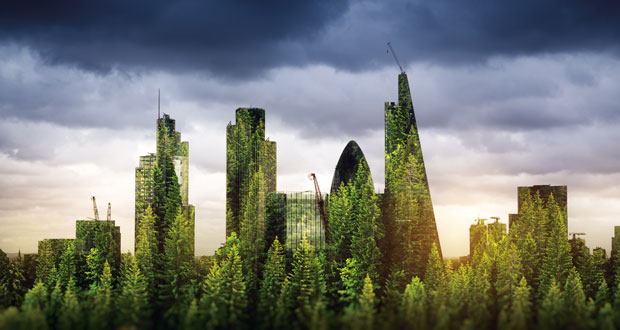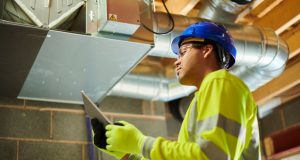 THE ESG EXPERT’S VIEW
THE ESG EXPERT’S VIEW
KATRINA CHRISTOPOULOS,
HEAD OF ESG AT CLOUD
Let’s be clear, there is no room for greenwashing in the middle of a climate crisis. When companies engage in greenwashing, it distracts from and devalues the efforts of businesses that are genuinely committed to sustainable practices.
According to the Climate Group, 40 per cent of global greenhouse gas emissions come from buildings. It’s hard to overestimate the impact that the FM sector can have on accelerating net zero.
Greenwashing can create fear that can deter companies from taking action. Transparency enables companies to make a start by embedding ESG goals in their culture and values. Begin with understanding what you’re measuring and why. The strategy can flex over time around issues, but the goal should remain the same. An evidence-led approach to sustainability plans ensures that the activity is not just tokenism.
Evidence also helps companies to demonstrate their environmental commitments are considered and effective. Where possible, these claims should be externally validated as it helps build confidence. At the very least, FM companies should assess their programs as if they were going to externally validate them to understand if they would make the cut.
Proper initiatives are crucial. Sustainability goals should be challenging, especially over the long term. The ESG challenges facing us all are immediate and significant, so it is important not to be too safe with goal setting. There needs to be a strategic approach, with ideas on how goals will be met and what budget is required. Using data is key to informing planning, measuring a baseline, and putting in place initiatives that show how reductions can be made.
Cloud has already achieved scope 1 and 2 carbon emission goals. However, scope 3 requires a closer understanding of the carbon emissions of the supply chain.
Scope 3 is a big task that requires immediate action. It starts with understanding supply chain emissions and working on initiatives to support them to decarbonise. Cloud’s Freedom platform has proven invaluable in assigning local engineers to jobs and is currently being upgraded to collect per-task carbon emissions. The data it provides also allows for more efficient route scheduling to minimise mileage.
Fresh investment in advanced telematics is improving driver efficiency, and fleets are moving to electric vehicles or sustainable fuels. All these items have a plan and budget behind them, and the role of each is understood in the overall carbon reduction target.
Celebrating genuine progress and efforts is important, even if companies are not yet perfect. This can motivate continued improvement. By providing an environment that balances accountability with encouragement and support, companies can be motivated to take genuine and sustained action towards their sustainability goals.
The FM industry is in this together and will be much more powerful and successful if it collaborates to set common standards and share best practices. A collective approach can reduce the pressure on individual companies and foster a supportive environment for sustainable action that avoids greenwashing.

 THE ARCHITECTS’ VIEW
THE ARCHITECTS’ VIEW
MITAKSHI SIRSI,
DIRECTOR OF SUSTAINABILITY, BROADWAY MALYAN
WILLIAM POOLE-WILSON,
FOUNDER AND MANAGING DIRECTOR,
WILL+PARTNERS
In the labyrinthine world of modern architecture, the refurbishment of buildings emerges as a pivotal axis, promising a bridge between our historical inheritance and a greener future. But is this noble quest overshadowed by the spectre of greenwashing?
Refurbishment is architecture’s answer to the broader call of sustainability. Unlike the brute force of demolition, refurbishment respects the past and melds it with the aspirations of the future. It speaks to our need to conserve energy, reduce waste, and leverage available resources, contributing less to landfills and more to the soul of the edifice. But there also lurks greenwashing — a practice where entities feign eco-friendliness more fervently than they pursue it.
Does this suggest the refurbishment of buildings is greenwashing? Exploiting the intent of sustainability, dressing up minimal efforts in the garb of green credentials? Not necessarily, but greenwashing is problematic in the refurbishment sector. Developers might tout energy-efficient and solar-panelled facades, while in the core, the building may retain outdated, inefficient systems. A classic case is insulating an old building to claim reduced thermal loss, while neglecting to upgrade the HVAC systems, leading to inefficiencies. The facade remains just that — a facade, with the workings failing the test of true sustainability.
The pertinent question arises: have we got the answers right? We tend to use the term greenwashing a bit too loosely in the building sector. The term refers to false and misleading claims, selective information disclosure and token initiatives. This may be straightforward in the manufacturing of, let’s say, a pencil; but decision making in the building industry can be complex. When the intent is noble, can lack of skill be categorised as greenwashing?
The answer may lie in our commitment to authenticity and rigor. We need thorough energy audits, overhauls of mechanical systems, and genuine material innovations. Refurbishments should be scrutinised for lifecycle impacts, encompassing both embodied carbon & energy in structures and the efficiencies facilitated by the refurbishment. It also lies in recognising where this cannot be achieved – tall buildings, for example. The cost of refurbishing tall buildings means it might be pointless to repurpose to residential use cases.
What is needed is a systemic change in the way we do things in the AEC (Architecture, Engineering, and Construction) industry, but that requires a concerted effort from everyone involved! Heritage is an important aspect, but are we preserving for aesthetic record, or for posterity? And if so, do we need to overhaul the approach to conservation of historic buildings? These are difficult questions we need to ask and answer soon.
However, the industry is evolving – adaptive reuse projects serve as exemplars. These projects also showcase the potential of closed-loop systems, but we need move faster and convert the exemplars to the unexceptional.
Certifications such as LEED, BREEAM offer frameworks not just for compliance, but for leadership in sustainability. This commitment NEEDS to go beyond checklists. Regulations have a place in all of this, but only to a certain extent and taking care that they don’t curb innovation or foster mediocrity for the sake of compliance.
To ensure the validity of refurbishment criteria – precise measurement and verification are indispensable. Post-occupancy evaluations serve as reality checks against projected benefits, illuminating discrepancies and guiding future improvements. This continuous feedback loop ensures that refurbishment projects deliver on their sustainability promises. In sum, we must embrace genuine transparency, step beyond aesthetics, and adhere to rigorous standards. We can then say that we have “got the answers right”, thereby honouring our past and changing aspiration to a reality we actively shape.





